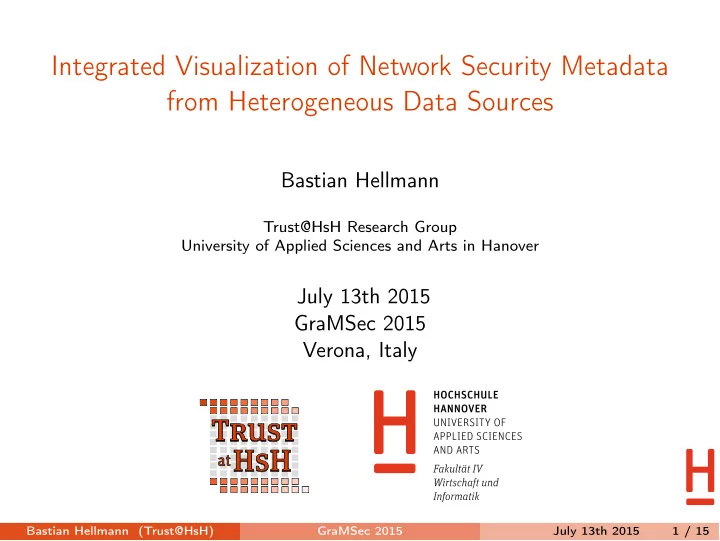

Integrated Visualization of Network Security Metadata from Heterogeneous Data Sources Bastian Hellmann Trust@HsH Research Group University of Applied Sciences and Arts in Hanover July 13th 2015 GraMSec 2015 Verona, Italy Bastian Hellmann (Trust@HsH) GraMSec 2015 July 13th 2015 1 / 15
Motivation Problem in Network Security Typical networks consist of various components like user endpoints, network security devices, services, . . . . Information is not shared among those components. Thus, an overview of whats going on is di ffi cult. Exemplary Use-Cases Detect combinations of failed login attempts on multiple services by the same user. Find the sources of the attack. Trace the way the attack moved in the network. React fast by shutting down accounts or locking out devices. Our Contribution Design and implement an integrated visualization, that works with data from various sources, and helps to detect and react to such attacks. Bastian Hellmann (Trust@HsH) GraMSec 2015 July 13th 2015 2 / 15
Requirements Real-Time Monitoring Acquire knowledge before it is outdated → Allows for faster reactions after detection of abnormal behavior Data Integration Combine information and knowledge from arbitrary components → Allows to combine knowledge Retrospective Analysis Preserve historical course of data and provide means to navigate in time → Events that led to a specific state can be retracted Bastian Hellmann (Trust@HsH) GraMSec 2015 July 13th 2015 3 / 15
Integration of Data Sources Types of data interesting for network security Physical and logical topology Configuration of devices & services State Behavior Our approach Use IF-MAP protocol as the foundation ( → next slides) Bastian Hellmann (Trust@HsH) GraMSec 2015 July 13th 2015 4 / 15
Interface for Metadata Access Points (IF-MAP) What is it? Open specification by the Trusted Computing Group Goal: allow exchanging information between arbitrary network components Data is defined in an extensible way and not bound to a domain Bastian Hellmann (Trust@HsH) GraMSec 2015 July 13th 2015 5 / 15
Proposed Architecture Analysis Visualization Data Processing Persistence MAP-Server IF-MAP Log fi le / Syslog IO-Framework NAC / VPN Flow Controller (N)IDS Collectors and Controllers Bastian Hellmann (Trust@HsH) GraMSec 2015 July 13th 2015 6 / 15
Application and Persistence Level Concepts Enhancements to IF-MAP Persistence of IF-MAP data, as the MAP server only holds the current state Continuous recording Preserve the changes (not only snapshots) as the MAP server receives them State and change queries Allow to query for snapshots , i.e. the complete graph at a given time Allow to query for the changes (delta) between two timestamps Bastian Hellmann (Trust@HsH) GraMSec 2015 July 13th 2015 7 / 15
Visualization Requirements and Concepts I Representing the data model IF-MAP forms a graph with nodes (identifier) and edges (links) and information attached to them Thus can be rendered with standard graph rendering techniques and layouts Publisher distinction The source (i.e. the MAP client measuring the data) of metadata needs to be transparent to the user Use the IF-MAP publisher-id to distinct between metadata from di ff erent clients (e.g. by coloring) Bastian Hellmann (Trust@HsH) GraMSec 2015 July 13th 2015 8 / 15
Visualization Requirements and Concepts II History navigation Navigation via three modes: live view , history view , delta view Selection of timestamps via slider and/or forward-backward-buttons Search Functionality and Filtering Allow the user to search or filter the graph data, to pinpoint a single node or a selection of nodes with similar features Search results can either be highlighted or colored di ff erently as non-matching nodes Non-matching nodes also can be shown translucent, to retain the overall structure Bastian Hellmann (Trust@HsH) GraMSec 2015 July 13th 2015 9 / 15
VisITMeta Application General information Research project, funded by German Ministry for Research and Education Released as open-source software 1 Implementation of all previous concepts O ff ers additional features like motion control (LeapMotion) 1 https://github.com/trustathsh/visitmeta Bastian Hellmann (Trust@HsH) GraMSec 2015 July 13th 2015 10 / 15
Screenshot (v0.4.2) Bastian Hellmann (Trust@HsH) GraMSec 2015 July 13th 2015 11 / 15
Specifics of IF-MAP Visualization Characteristics of IF-MAP graphs Two kinds of nodes: Identifier and Metadata Can and should be handled di ff erently when calculating layouts Example: Adapted Bipartite Layout Identifier in columns 2 and 4, Metadata in columns 1, 3 and 5 Emphasizes the di ff erence between link and single metadata Bastian Hellmann (Trust@HsH) GraMSec 2015 July 13th 2015 12 / 15
Results Homogenization IF-MAP used for acquisition and homogenization of di ff erent data sources Components need only be enabled to publish IF-MAP information Data context Implicit connection of di ff erent data like network addresses, user credentials, services and high-level events Interoperability VisITMeta as a software is usable in every IF-MAP-based environment as it uses standard mechanisms to fetch the data Many MAP clients and thus a good amount of data sources already available Continuous recording and retrospective analysis Changes are persisted as they are processed by the MAP server They can then be reconstructed step by step Bastian Hellmann (Trust@HsH) GraMSec 2015 July 13th 2015 13 / 15
Indentified Challenges Visual Scalability Big graphs get cluttered really quick Techniques to reduce the size of the graph have to be added, like Level of Detail Visual dynamics Frequent changes in the network lead to many changes in the visualization E.g. do not show low-level data and concentrate instead on high-level abstractions Recording of all data Mechanism to fetch data from the MAP server has a shortcoming implied from IF-MAP itself: only connected graphs can be observed via a subscription IF-MAP does not o ff er a mechanism to get to know if there are new and disconnected graphs. Bastian Hellmann (Trust@HsH) GraMSec 2015 July 13th 2015 14 / 15
Conclusion Summary Requirements for data integration including model and requirements for visualizing the data IF-MAP as foundation Graph-based visualization with regards to IF-MAP structure Features like history navigation and filtering Future Work Address the identified challenges Using data persistence for analysis Bastian Hellmann (Trust@HsH) GraMSec 2015 July 13th 2015 15 / 15
Recommend
More recommend